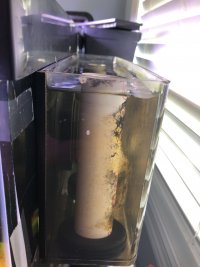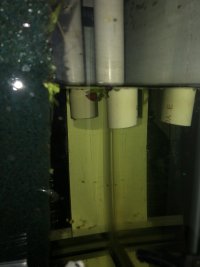NotoriousENG
Member
Hi Everyone,
I noticed during leak testing this week that there is a bit of strangeness going on with trying to tune my overflow. The tank in question in s a 20 gallon long with a 10 gallon sumped powered by a Jebao DCP 2500 pump. The overflow box is an Eshopps eclipse S plumbed in a standard Herbie configuration with 1 inch PVC main and emergency drains. At low pump power (<40%) everything is fine, the overflow is very quiet and the water level in it is consistent. However, at higher pump levels (>40%) I am having issues with the inconsistent water levels in the overflow box. I am able to use the gate valve on the main drain to dial in the siphon rate so that there is just a trickle into the emergency drain. Everything seems to be good for anywhere from 10 minutes to an hour until the water level in the overflow box drops rapidly. If I let it keep running the overflow water level slowly creeps back up over the course of 5 minutes or so and is good for another half hour or so before it water level suddenly drops and the cycle starts over. Throughout this whole cycle, the water in the main display tank seems to be consistent so I am at a loss for what is happening.
I also have noticed a lot of splashing noise from the weir box at higher flow levels and am wondering if people have any suggestions on how to quiet it down.
I noticed during leak testing this week that there is a bit of strangeness going on with trying to tune my overflow. The tank in question in s a 20 gallon long with a 10 gallon sumped powered by a Jebao DCP 2500 pump. The overflow box is an Eshopps eclipse S plumbed in a standard Herbie configuration with 1 inch PVC main and emergency drains. At low pump power (<40%) everything is fine, the overflow is very quiet and the water level in it is consistent. However, at higher pump levels (>40%) I am having issues with the inconsistent water levels in the overflow box. I am able to use the gate valve on the main drain to dial in the siphon rate so that there is just a trickle into the emergency drain. Everything seems to be good for anywhere from 10 minutes to an hour until the water level in the overflow box drops rapidly. If I let it keep running the overflow water level slowly creeps back up over the course of 5 minutes or so and is good for another half hour or so before it water level suddenly drops and the cycle starts over. Throughout this whole cycle, the water in the main display tank seems to be consistent so I am at a loss for what is happening.
I also have noticed a lot of splashing noise from the weir box at higher flow levels and am wondering if people have any suggestions on how to quiet it down.





